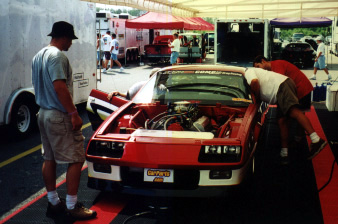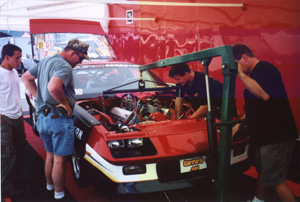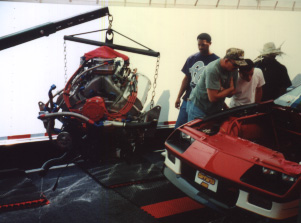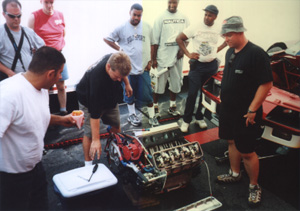Reading, PA -- With the completion of the events at Gateway Raceway Park in St. Louis and at Maple Grove Raceway Park near Philadelphia, we have moved a few steps closer to the close of our 2000 racing season.
Here’s a run down of how the Gateway and Maple Grove races went for us.
We departed for St. Louis with a lot enthusiasm and some pretty lofty expectations. It’s amazing what one good pass will do to you. To make matters worse, I had been religiously tracking the weather for the entire week leading up to the event. Our excitement only grew as the weather was shaping up to be very similar to the conditions for our 7.89 pass. Unlike Joliet, Gateway is a track with a reputation for having "teeth" and I was further fired up by that notion. In my mind there was no doubt that we were going to better our Joliet performance.
Silly me… The atmospheric conditions were exactly as anticipated, but the track conditions were horrible. There were big starting line bald spots and the racing surface was as slippery as a bowling alley. Qualifying was a challenge for us. Even though our split times and MPH through the front half were poor, the car would charge pretty well through the back half despite the poor track conditions. We managed to slip and slide into the #9 qualifying spot with only an 8.19 best. We were all pretty disappointed with our qualifying results. At that point, we decided to make some "aggressive" rear suspension changes. Before we started with the changes, we noted the current set-up. It was at that point that we discovered a problem with the configuration we had been running. So now we were faced with another after hours thrash. We worked fairly late completely re-doing the rear suspension set-up.
As per usual for us, our qualifying struggles earned us the #2 qualifier in the first round. We finally got a break though. A starting line malfunction for our opponent resulted in a winning 8.11 solo pass for us. The 8.11 pass showed us that the suspension changes that we made were a step in the right direction.
 We received another gift in the second round when the competition red-lighted. Our luck came to an end when engine damage kept us from potentially winning the third round. The good news is that our semi-final finish gathered us enough points to pass a few of our competitors and slide up into the 8th position, the bad new is a post race autopsy revealed that we had hurt cylinders 3 and 5. Hmm… 5 again. I caught a lot of grief from the crew and some fellow racers for "staying in it" to long. "Didn’t you feel the thing nose over?" somebody asked. NO! I didn’t… The car ran an 8.20-something even though I lifted well before the 1000’ cone! It was pulling hard… what do you mean, "nose over"? The only reason I lifted was because the car was filling with smoke and at the same time I noticed oil was coming in through the trans tunnel. It wasn’t until then that I knew something was seriously wrong. I killed the ignition to keep the oil from catching fire. Then I hit the parachute to keep the car straight in case the tires were being oiled. Hurting the engine is one thing, but hitting the Gateway railing at 100-and-some-odd MPH on top of it, is another. The oil was coming from a valve cover gasket that had been "pushed out" after damaging the pistons.
We received another gift in the second round when the competition red-lighted. Our luck came to an end when engine damage kept us from potentially winning the third round. The good news is that our semi-final finish gathered us enough points to pass a few of our competitors and slide up into the 8th position, the bad new is a post race autopsy revealed that we had hurt cylinders 3 and 5. Hmm… 5 again. I caught a lot of grief from the crew and some fellow racers for "staying in it" to long. "Didn’t you feel the thing nose over?" somebody asked. NO! I didn’t… The car ran an 8.20-something even though I lifted well before the 1000’ cone! It was pulling hard… what do you mean, "nose over"? The only reason I lifted was because the car was filling with smoke and at the same time I noticed oil was coming in through the trans tunnel. It wasn’t until then that I knew something was seriously wrong. I killed the ignition to keep the oil from catching fire. Then I hit the parachute to keep the car straight in case the tires were being oiled. Hurting the engine is one thing, but hitting the Gateway railing at 100-and-some-odd MPH on top of it, is another. The oil was coming from a valve cover gasket that had been "pushed out" after damaging the pistons.
Anyhow… We returned home, plucked the engine and cannon-balled it over to Fast Times Motorworks for repairs. We only had a few days before we would have to leave for the next event. Thanks to the hard work of the entire Fast Times gang, they were able to execute the necessary repairs in time for us to make the Maple Grove event. A special thanks goes out to those FTM crew for getting us back to the track. Thank you guys!
After St. Louis, I had no idea what to expect in Maple Grove. The oxygen meter said that there was lots of O2 in the air. So the potential to easily melt pistons was there. With that, we backed the nitrous tune-ups WAY off, with a little extra out of our problem children, #3 and #5. We did this just to be safe and to find our feet again.
 The first round of qualifying paired us up with my Canadian arch-nemesis, Dangerous Donnie Moore. Our car left hard, went straight, and really made a strong charge for 2nd gear. A quick check of the gauges indicated that everything was proceeding smoothly. I pulled high gear and the car continued pulling hard. At 8,200 RPM our "miss" in the engine showed up just like it always does at 8,200. It sounded worse then it normally does though. It sounded just like it does when a piston has been burned and the spark plug has been trashed. But there was no way this thing could have burned a piston! We backed off the nitrous, added fuel, and took out timing. The vacuum gauge was steady as well. It ran 8.05 @ 174. It went almost 141 MPH to the 1/8. There was just no way it was hurt. Well guess what? I was in denial. It nipped piston #5 again. Everybody was baffled as to how it could have still managed to melt #5. The data acquisition revealed that the engine ate the #5 piston about 2.1 seconds into the run. From that point on, car was down on power and it still ran an 8.05. Had all of the pistons been intact for the entire run, the car would’ve surely run well into the sevens.
The first round of qualifying paired us up with my Canadian arch-nemesis, Dangerous Donnie Moore. Our car left hard, went straight, and really made a strong charge for 2nd gear. A quick check of the gauges indicated that everything was proceeding smoothly. I pulled high gear and the car continued pulling hard. At 8,200 RPM our "miss" in the engine showed up just like it always does at 8,200. It sounded worse then it normally does though. It sounded just like it does when a piston has been burned and the spark plug has been trashed. But there was no way this thing could have burned a piston! We backed off the nitrous, added fuel, and took out timing. The vacuum gauge was steady as well. It ran 8.05 @ 174. It went almost 141 MPH to the 1/8. There was just no way it was hurt. Well guess what? I was in denial. It nipped piston #5 again. Everybody was baffled as to how it could have still managed to melt #5. The data acquisition revealed that the engine ate the #5 piston about 2.1 seconds into the run. From that point on, car was down on power and it still ran an 8.05. Had all of the pistons been intact for the entire run, the car would’ve surely run well into the sevens.
 The damage appeared to be minimal, so we immediately got started with repairs. As we began to disassemble the engine, we found the out why it cooked #5. The cam-sync sensor pick-up and magnet had collided, destroying each other. We had probably done this before we even left the shop. The trashed sensor disabled the individual cylinder control benefit of the electronic fuel injection system. That is why #5 melted even though we thought we were being extra safe with it.
The damage appeared to be minimal, so we immediately got started with repairs. As we began to disassemble the engine, we found the out why it cooked #5. The cam-sync sensor pick-up and magnet had collided, destroying each other. We had probably done this before we even left the shop. The trashed sensor disabled the individual cylinder control benefit of the electronic fuel injection system. That is why #5 melted even though we thought we were being extra safe with it.
A few hours later, we had the engine fixed and back in the car. We probably could have made 3rd qualifying session, but we decided not to push it. We were qualified in the #3 spot, the silicone needed to dry and we hadn’t found another cam-sync sensor. Besides, Prock needed the extra time to examine the tune-up and compensate for the individual cylinder control being disabled. At the end of qualifying, we had only slipped two spots to #5.
Sunday’s first round of eliminations brought us a break. Our first round competition had problems of there own leaving us with what would equate to a test and tune solo pass. Prock had worked on the naturally aspirated starting line launch map, which had paid off well on the launch. When the nitrous map took over after launch the car felt really "soggy". Once it started firing through the exhaust, I aborted the run.
 When we returned to the pits, we found that one of the plug gaps had closed. This undoubtedly had contributed to the car not running that well in the 1st round. A new spark plug and a refined tune-up sent us off to the second round. The car again launched very cleanly. As I progressed down the track, the car still felt "soggy", but not quite as bad. Then it started firing through exhaust again. I again aborted the run, giving or competitor an easy pass into the 3rd round. Another weekend was over.
When we returned to the pits, we found that one of the plug gaps had closed. This undoubtedly had contributed to the car not running that well in the 1st round. A new spark plug and a refined tune-up sent us off to the second round. The car again launched very cleanly. As I progressed down the track, the car still felt "soggy", but not quite as bad. Then it started firing through exhaust again. I again aborted the run, giving or competitor an easy pass into the 3rd round. Another weekend was over.
The twenty additional points that we received for our 1st round bye were enough to move us up one more spot to #7 in the point standings, a nice consolation for another tough weekend at the track.
The past few weeks have been an exercise in frustration. Our hopes of finally turning the proverbial "corner", unfortunately, have not materialized. We are still struggling just to cleanly get down the track. We’ve been plagued by several nagging problems that just won’t go away. You may recall my mention of our combination being somewhat "finicky". The more we work with our combo, the more we find how finicky our combination truly is. The engine and suspension tune-ups that work one weekend do not even come close to working the next. Needless to say, we are still working to establish the baseline set-up that will allow us to go relatively fast anywhere, anytime. I’d like to say we are getting closer, but in all honesty, I can’t.
We get a few weeks off before we head of to he last two races of the season in Memphis and Atlanta. In the mean time, we’ll be making a bunch of changes/adjustments/refinements to the car in an attempt to make this car do some thing. We are planning some major adjustments to the entire suspension system. We are also beginning to feel that transmission change is necessary due to the short stroke and high operating RPM of the engine. The 8,200+ RPM "miss" has got to go, especially considering that I shift at 9,000. We’ll be making some adjustments in a last ditched attempt to try and make it go away. If that doesn’t work, we’ll be replacing the Crane ignition box and coil with comparable pieces from MSD. We may even do some testing before the last two events depending on things. Be sure to check back later. If we do some how manage to get out to test, we’ll have the results put up here. If we don’t, you’ll hear from us after the Memphis and Atlanta events. Until then…
Ted & Tim Pelech
Pelech Bros. Racing

